This is part 6 of a series that walks through the slides in a pitch deck. See Start With the Problem, and Your Startup’s DNA: The Solution Slide, How Not to Waste Your Product Slide, Why Now: Change is the Key to your Pitch, and The Market Size Dilemma.
Talking about competition is hard
There is probably a psychological basis for entrepreneurs not wanting to find competitors because it’s too painful. It’s like most parents thinking their children are beautiful but not wanting to disprove it. Understandable.
This post is about how to talk about competition in a convincing way. I’ll provide tools and guidance for founders to do a self-assessment of their Competition slide. Often, entrepreneurs are annoyed or even blindsided by questions they get from investors. This will help you prepare.
I do not cover how to actually do competitive research which is another topic. But hopefully you’ve done that before building your slide.
The goal of the competition slide is to explain how you are different from others in ways that let you capture market share and defend it.
Use this simple definition to guide your thinking about the competition slide. It breaks down into three parts:
- Different does not equal better.
- Better does not necessarily capture market share
- Capturing market share does not mean you can defend it
If your competitive analysis only shows how you’re different you still have more work to do. Always ask yourself “so what?” when it comes to talking about why you’re better than competitors. You have to be better in a way that translates into more sales. You also need to look to the future. Imagine you’re successful at being different and using it to capture market share. Then how will you defend this advantage when competitors react?
Key points I cover:
- Don’t orphan your competition slide
- Avoid using tables
- Use a map to show why you’re different
- Not all competitive advantages are equal
Subscribe for free to receive weekly posts about pitching, a copy of my ebook Pitching a Leap of Faith, and invites to my Pitch Masterclass.
Don’t orphan your competition slide.
The most valuable thing you can do to improve your competition slide is to connect it to the rest of your slides. Often, a competition slide seems out in left field and introduces new concepts not covered elsewhere. But it’s actually one of the slides that pulls together many other parts of your pitch.
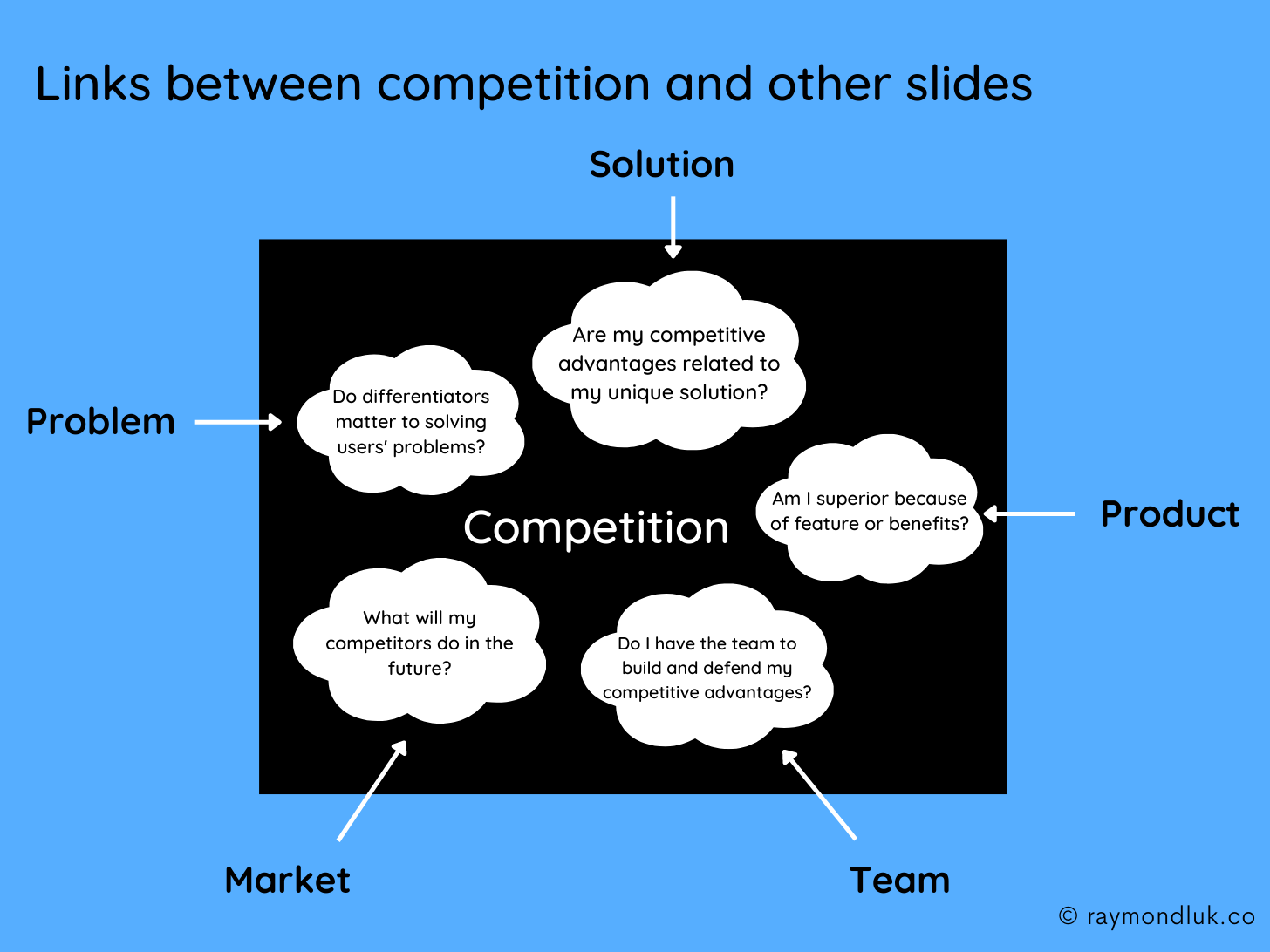
Solution
There is a direct link between your Solution and your Competition slides. Why? Because whatever you said was unique about your product, i.e. your unique approach, should be one of the ways you’re better than your competitors. Otherwise you’re saying, “we have this unique solution but it’s not helpful.”
Problem
It’s very easy to get tunnel vision about showing how you are different than others. Always refer back to the problem and make sure you’re different in ways that matter to your users and specifically addresses their pains and gains.
Product
Features should rarely appear on your competition slide because they can be copied. Be wary of saying you’re superior because you have more features (see next section).
Market
Most competitive analyses never mention how competitors will react. E.g. if you start capturing market share in a profitable niche, why wouldn’t they copy what you’re doing? The work you did to answer Why Now? is very useful here to explain how market forces are changing in your favour.
Team
Finally, your competition and your team slides are related. Whatever you say is your unique competitive advantage sets up the question, “who on the team is an expert on that?”
Avoid using tables
When you shop online for a computer there’s a “compare products” button so you can compare things like CPU speed, memory, GPU etc. That’s what I think about when I see competitive analysis as a table.
It makes you appear more similar to your competitors than different. But most startups want to show how they’re disrupting a market, not fitting within it. It’s difficult to show disruption in a side-by-side comparison.
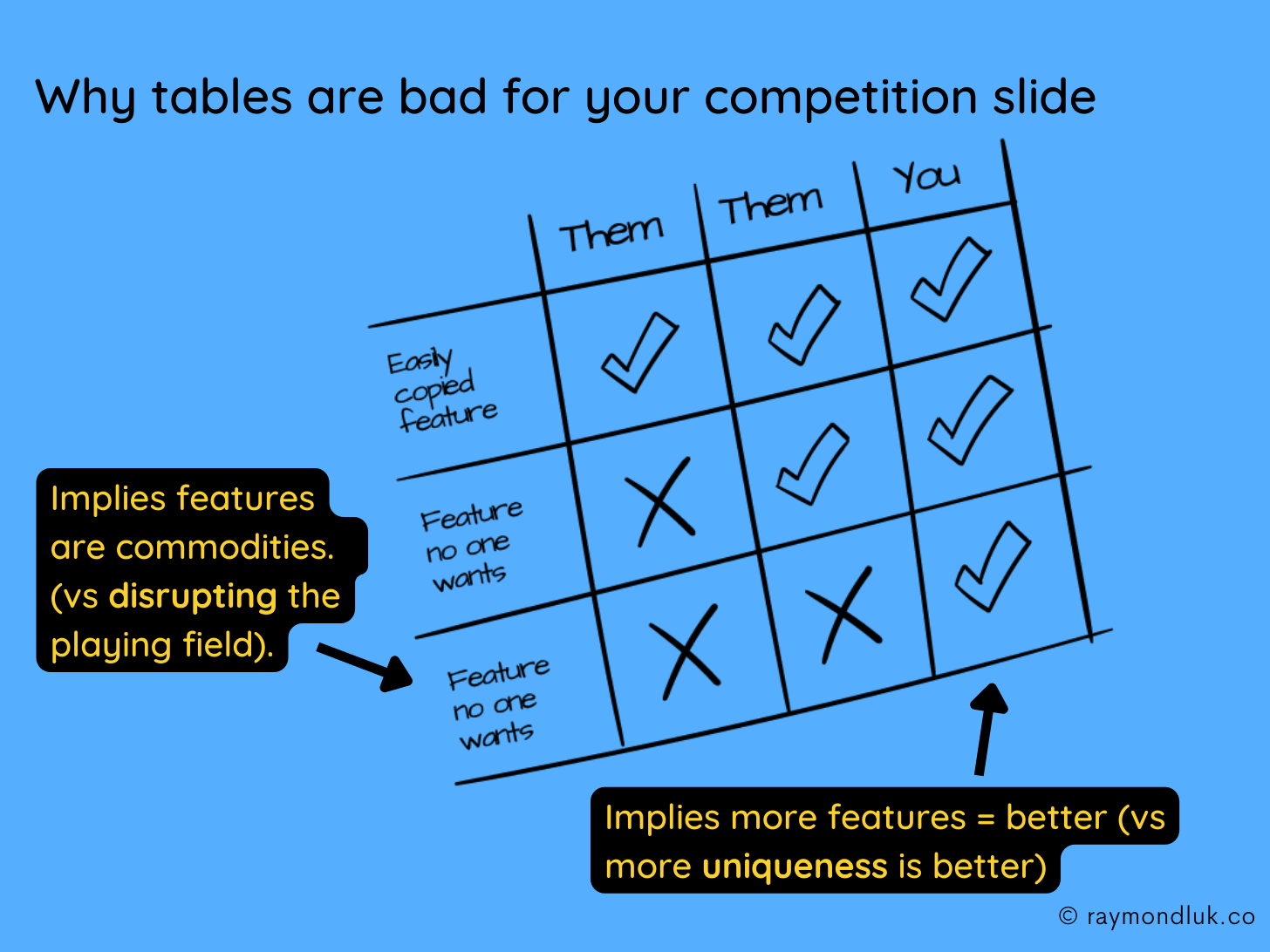
A table also implies that “more is better” which is rarely true. You’ll be tempted to add lots of features to give you more checkboxes. Adding all this ‘stuff’ only obscures a better story about why you’re unique. Read on.
Use a map to show why you’re different (in a good way)
A competitive map is a better way to talk about competition. This 2-axis diagram forces you to make bold statements about why you’re different, i.e. you can only pick two things. It’s also a better way to talk about the future behaviour of competitors.
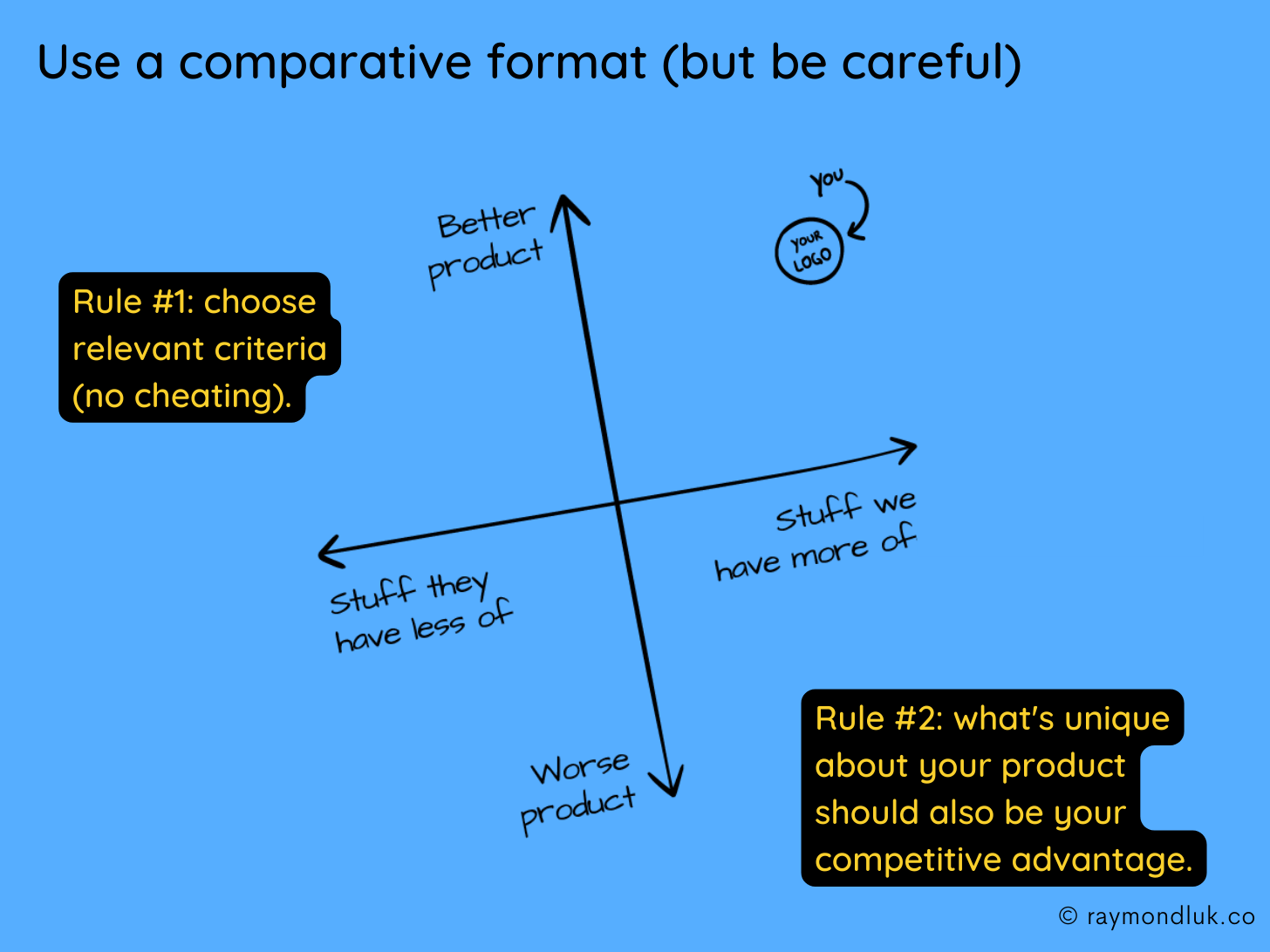
Before copying and pasting your logo in the top right, do an honest evaluation of what criteria you’re using. They should strongly relate to your unique solution and not just be features based. Don’t cheat by picking whatever criteria put you in the top right (this happens in 90% of pitch decks).
Also, whenever you add a competitor’s logo to the map, draw an arrow showing where they will go in the future. It might be too busy a design to show all the arrows but you should be able to talk about not just this moment in time, but how it changes in the future.
An even better approach is to use half the slide for this map and the other half to explain why you chose those criteria. I see this in very few pitch decks, but they really stand out for how convincing they are.
Not all competitive advantages are made equal
I’ve been thinking a lot about how to classify different types of competitive advantages. I’ve created a simple framework to help entrepreneurs evaluate them.
There are advantages you control (e.g. IP) and others that depend on others (e.g. supply chain). I’ve separated things that are easier or more difficult to copy understanding that there are very few things that are immune to being copied given time and resources.
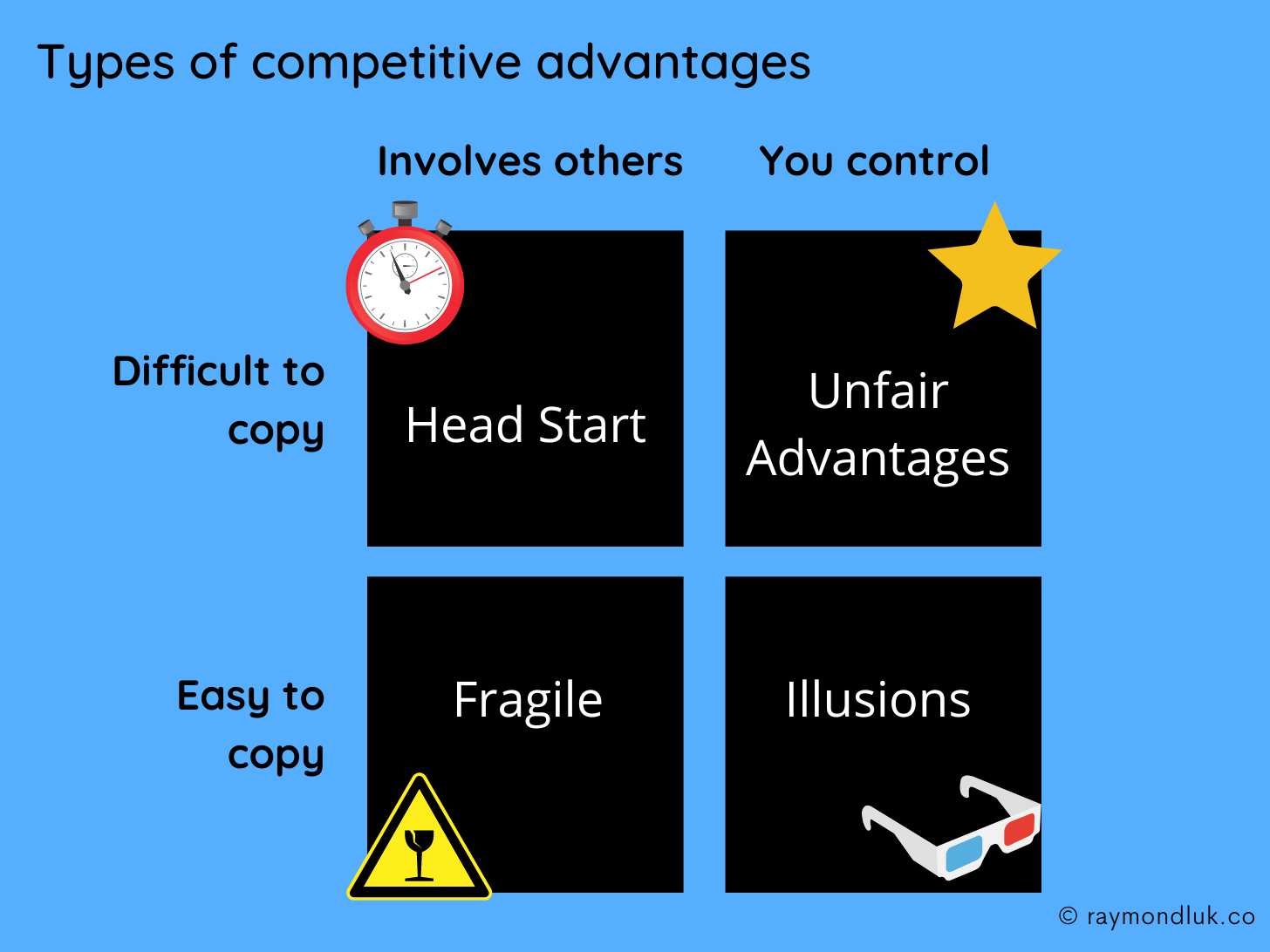
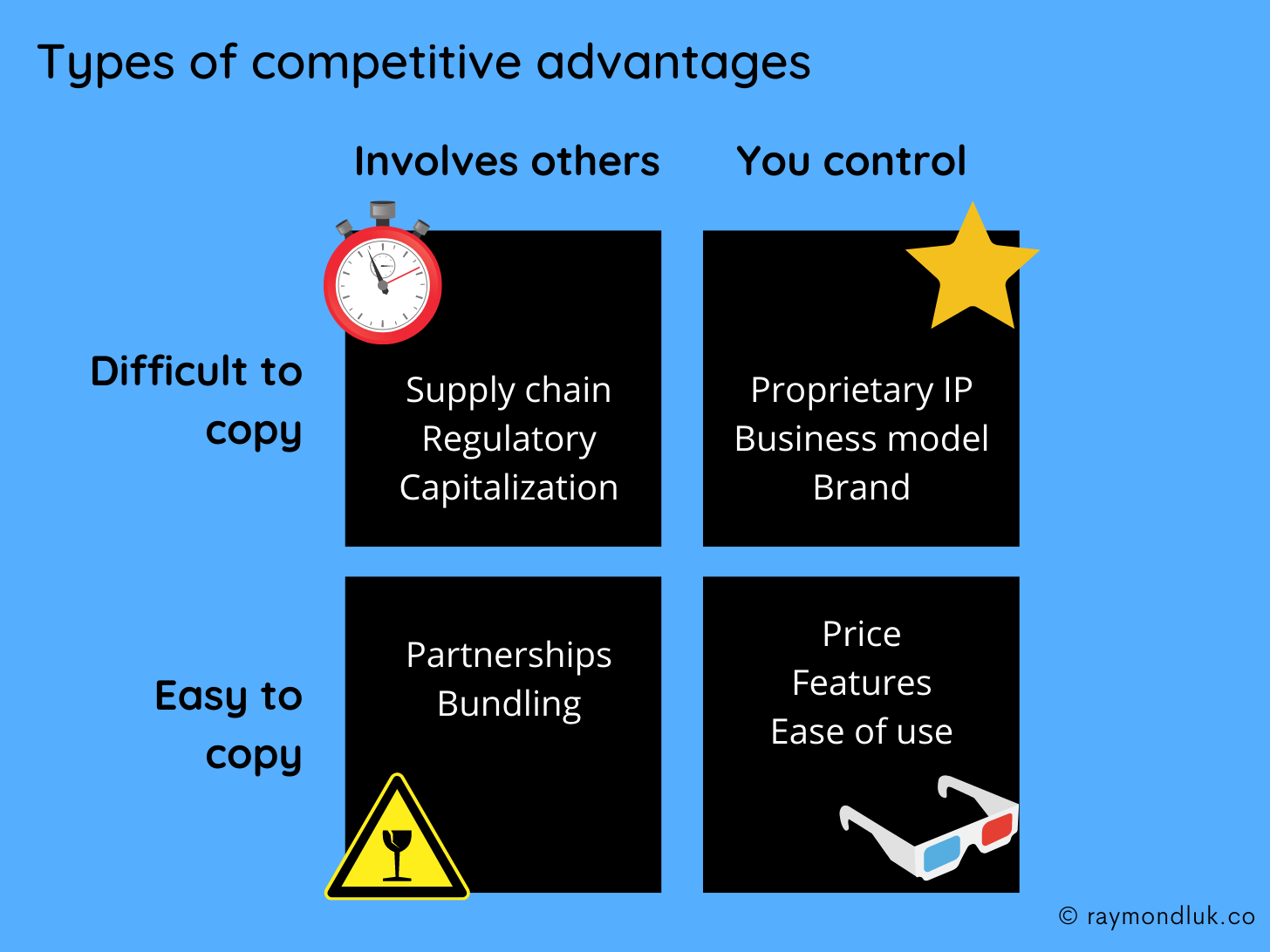
Unfair advantages
These are your ideal competitive advantages because they are under your control and your competitors can’t easily duplicate them. Proprietary IP could be a patent or trade secret. A new business model, like freemium, could be difficult to copy without hurting their existing business. A unique brand falls in this category but usually takes time to establish.
Most startups will not end up having true unfair advantages. I’m not saying that’s a problem or you need to strive to be in the top right. The point is to be aware that when you say the words “unfair advantage” an investor has a very high bar. Sometimes, it’s good enough to just have a head start.
Head starts
Only things that are difficult to copy are real head starts. Having a head start of even a year might be all the competitive advantage you need. When you’re asked “Why can’t X do what you’re doing?” it’s better to answer “because we have a head start of 2-3 years” vs “they can’t.”
Building a unique supply chain and locking in suppliers and distributors is not impossible to copy, but takes time, potentially years. Being in a regulated industry gives you a head start equal to the time it takes to jump through those hurdles, which can also be years. Even successful fundraising can give you a head start (or your competitors if they raise more money than you).
Fragile advantages
Many competitive advantages exist now but can easily be duplicated if someone chose to. One claimed competitive advantage I see a lot is being integrated with other products. But unless those are exclusive, it’s easy to copy. So partnerships and bundling are not strong competitive advantages, though they may be important to your go to market.
Illusions
I call this category “Illusions” because they are the most deceptive competitive advantages. Unfortunately, they’re also the most frequently seen.
Features are weak because they can be copied. If a 5-person startup can build 10 features in 6 months, a bigger competitor can probably copy it even faster. The biggest mistake you can make is saying what makes you unique is a feature. First, it’s not self-evident that other features or approaches wouldn’t be just as good, or better. Second, unless there’s strong IP protection, which is rare for a feature, it can be copied.
Price is another illusion. Unless it’s truly disruptive (like free), a lower price is usually not enough to overcome inertia and get people to switch to a new, unknown solution. When I see lower price as a startup’s competitive advantage I think that they couldn’t find something more innovative besides a discount.
Ease of use, besides being subjective, is easy to copy. I’m not saying taking something difficult to do and making it easy is not a fantastic strategy. But be aware competing on ease of use raises two questions:
- Do you have a world-class team in product design?
- How will you keep ahead of fast followers in the future?
Having built your product on extensive user testing or behavioural research makes ease of use a more convincing competitive advantage.
Summary
All companies have competition and startups have an even bigger uphill battle to build an organization and compete with bigger, more established companies. Investors understand this and do not want you to minimize competition.
The most convincing competitive analysis is based on a small number of bold statements about why you’re better. Evaluate those statements and make sure you understand if they are unfair advantages or head starts and don’t confuse the two. Most importantly, avoid things that seem like advantages, like more features and lower price, that are easy to copy. Those are illusions most investors will see through.




